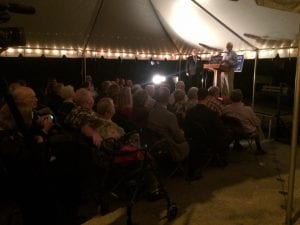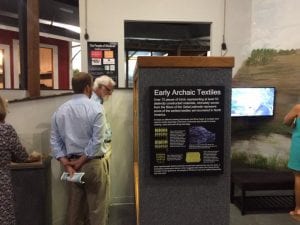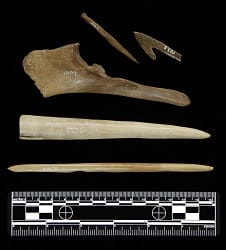Windover Burial Site Refresh
 Anthropology graduate student, Patrisha Meyers, is the director of the Brevard Museum of History and Natural Science and the Florida Historical Society Archaeological Institute. Meyers has overseen the improvements and expansion of the exhibit “People of Windover” or the Windover refresh. The Windover Archaeological Site, the most significant burial complex in North America, is a charnel pond used by early hunter-gatherers more than 7,000 years BP.
Anthropology graduate student, Patrisha Meyers, is the director of the Brevard Museum of History and Natural Science and the Florida Historical Society Archaeological Institute. Meyers has overseen the improvements and expansion of the exhibit “People of Windover” or the Windover refresh. The Windover Archaeological Site, the most significant burial complex in North America, is a charnel pond used by early hunter-gatherers more than 7,000 years BP.
On Friday, November 13th, at the re-opening of the Windover exhibit, Florida Today interviewed Meyers, discussing the importance of the Windover archeological site and the significance of the new Windover exhibit to the community.
Meyers received her undergraduate degree at UCF in anthropology in 2012 and returned to UCF in the fall of 2013 to complete her M.A. in anthropology with John Schultz, Ph.D., as her graduate advisor. Last April, Meyers was hired for the position of Director of the Brevard Museum of History and Natural Science, as well as Director of the Florida Historical Society Archaeological Institute.
She believes that her “…background in anthropology and skeletal analysis, as well my solid foundation in research methods, were skills that weighed heavily in my favor as a candidate for these positions.”
The Brevard Museum of History and Natural Science opened its doors on May 20th 1973, and has served the community continuously since that time. In September 2014, a new era began when the museum came under the umbrella of The Florida Historical Society, the state’s oldest cultural organization.
 The Windover archaeological exhibit, which is the centerpiece of the museum, details one of the most significant archaeological discoveries in the world, providing new information about prehistoric people. It is arguably the most important burial complex in North America.
The Windover archaeological exhibit, which is the centerpiece of the museum, details one of the most significant archaeological discoveries in the world, providing new information about prehistoric people. It is arguably the most important burial complex in North America.
The site was discovered in 1982 when Steve Vanderjagt, a backhoe operator working for Jim Swann’s development company, EKS Corporation, lifted his bucket from the bottom of a pond and found a human cranium mixed in with the soft peat. Once investigators determined that the remains were archaeological in nature, Jim Swann approached Glen Doran, Ph.D., at Florida State University and requested an archaeological investigation of the site.
The pond was excavated over three field seasons from 1984-1986, revealing the remains of 168 individuals of all ages from neonates to advanced old age. Radiocarbon dating indicated that the Windover people lived between ~7,000 – 8,000 BP making this the largest and oldest mortuary pond complex yet uncovered.
The Windover refresh was made possible through a grant from the Florida Humanities Council. “Updating this exhibit has been the highlight of my time here as director” says Meyers.
Working with Katherine Page, the museum curator, as well as an UCF anthropology alumna, the museum updated the mock-up of the archaeological site itself, which includes a beautiful collection of Windover artifacts on loan through the generosity and kindness of Rochelle Marrinan, Ph.D., Department Chair, at Florida State University’s anthropology department and Geoffrey Thomas, Ph.D., Specialized Teaching Faculty and Interim Curator of the Windover collection.
 The Brevard museum also contracted with local artist Brian Owens to create a bust entitled “Windover Women.” Based on a forensic reconstruction completed in Scotland, along with actual measurements of one of the Windover skulls, she is a lifelike representation of what one of the women from this population would have looked like.
The Brevard museum also contracted with local artist Brian Owens to create a bust entitled “Windover Women.” Based on a forensic reconstruction completed in Scotland, along with actual measurements of one of the Windover skulls, she is a lifelike representation of what one of the women from this population would have looked like.
Florida Today quoted Meyers saying how “[t]he Windover site is actually the most important burial site in North America.”
She stated that “[o]ne of the things that makes it so significant is the unique type of burial. It’s a pond burial; we don’t see that as often, and this is the most complete population that has been excavated from this period…[t]hey were able to excavate 168 individuals ranging in age from infancy to old age, and because of that, we were able to learn a great deal about these early lifeways.”

Bone and Antler: A variety of materials were used to make tools (from top to bottom): 1) bone fishing barb, 2) bone pin or batten, 3) deer ulna tool, 4) antler projectile point, 5) bone projectile point.
The exhibit has all new interpretive panels and a hands-on laboratory component designed to help visitors understand how physical anthropologists assess biological characteristics such as age, sex and stature from skeletal remains.
Meyers said “[t]he most exciting part of the refresh, for both myself and Katherine, was the day we spent in the Florida State University anthropology department analyzing several individuals from the Windover population in order to create new osteobiographies for our interpretive panels.”
The Windover exhibit re-opening was paired with a gala charity benefit on Friday and a free public day on Saturday. The public day included a panel discussion covering both the original archaeological dig, as well as the Windover collection’s ongoing importance as an active research collection.
Meyers expressed her excitement about the “…full house crowds for both events! Florida Today has provided extensive coverage both leading up to and following the event and we are happy to see the community embrace this unique and inspiring cultural resource in Brevard County.”
